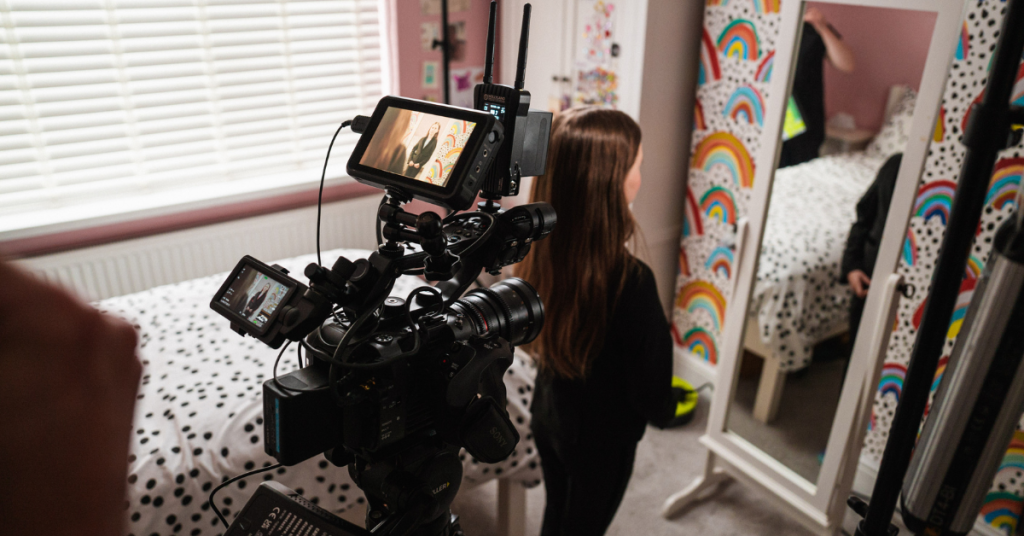Introduction to a Video Marketing Strategy
Video marketing is a powerful tool for businesses looking to engage audiences and drive conversions. This comes as no surprise, with social platforms now prioritising video above other forms of media and search engines reward websites that use video content.
Add to this the rise in popularity of targeted television adverts on platforms such as Sky AdSmart and other streaming services, ultimately, if you aren’t utilising video in some way – you’re falling behind.
We’re aware of how daunting developing a video marketing strategy can be. Each platform requires a different approach, which can make it feel like a video marketing strategy is something overly complex.
From the unpolished organic approach favoured on TikTok, the aesthetically perfect shots for Instagram, and the high-quality, super unique ideas for television adverts – it’s no surprise that marketing teams are saying, “Where do we even start!?”
Between trying to tell your bosses you can’t make the logo bigger and explaining why we can’t just “make something viral,” developing a new multi-faceted strategy can be overwhelming.
That’s why we’ve put together this handy guide, empowering you to break through the fuss and start building a video marketing strategy that will take your marketing approach to the next level.
Table of Contents
- Step One: Understanding Your Audience
- Step Two: Setting Goals & KPI’s
- Step Three: Establishing Your Video Marketing Ideas
- Step Four: Tackling Your Video Production
- Step Five: Promoting Your Videos
- Step Six: Measuring Success & Reporting
Here at Reels in Motion, we’re experts in producing Video Marketing content – we can guide you in developing your strategy. With over 20 years of experience in video production, you can be confident we’ll bring your vision to life.

Your 6-Step Guide to a Video Marketing Strategy
Step One: Understanding Your Audience
Arguably the most important factor in your Video Marketing strategy is understanding your audience. Knowing who will watch your content, means you know what they want to see.
Identifying Your Target Audience
Start by identifying and understanding your current audience. You could do this in several ways:
Partnering with a Data Management Company: Partnering with an external data management company is a great way to understand your audiences better. Using someone like Experian, who is well established and will have access to a huge amount of information, will support you in drilling down into who your customers are. They will cross-reference your customer data with their own to determine the main demographic profiles that make up your customer base. They can also provide you with profiles for who you should be targeting next. They will be able to provide details such as the media consumption, house type, and income of your customer base. While very straightforward, keep in mind this can be fairly costly.
Undertaking Own Research: If you are a business-to-business marketer or an agency, you have the benefit of accessing heaps of information about your clients simply by researching the company online. Whether that be monitoring your top client’s company social media accounts or scrolling their website to see what values the company celebrates. This is a great way to start understanding your customers and identify common themes and indicators about who they are.
- Conducting Customer Research: Gathering feedback is a great way to understand your audience. While it’s important to be cautious when gathering customer feedback, as people may respond with what they think they “should” say, it’s valuable to gather information straight from the horse’s mouth. Asking questions such as “What brand values are most important to you” and “What media do you use to get your information” are great questions to gather information.
Top Tip: Use an incentive, such as a £50 Amazon voucher, to encourage responses.
- Social Media Analysis: Use social media analysis and testing to understand the content your customers interact with the most. Look historically at what has performed well, and what hasn’t. This will help you to build a picture of what your clients like in terms of their media consumption.
Create Your Buyer Personas
Once you have gathered all your information and feel confident you have all the insights you need, you should use this to create buyer personas. This means you humanise all the data you have gathered. We would recommend creating 3-4 buyer personas to ensure you can highly target and segment your messages to the different personas. These buyer personas can be both existing clients and leads who you would like more of in your database.
An example buyer persona:
Sarah Thompson, 38, is the Marketing Director at a mid-sized technology firm in Manchester, UK. She has over 15 years of experience in digital marketing, leading a team of 10 professionals. Married with 3 children, Sarah is driven to enhance her company’s brand awareness and lead generation through high-quality, engaging content. She values creativity, innovation, and data-driven decision-making but faces challenges with limited in-house resources for video production and tight deadlines.
Sarah seeks a reliable video production company that can deliver professional, tailored B2B marketing videos. She prioritises partners who understand brand consistency and provide a seamless process from concept to final edits, including detailed performance analytics. Your company’s comprehensive video marketing services and proven success in the tech industry align perfectly with Sarah’s needs, making you an ideal partner for her marketing goals.

Step Two: Setting Goals and KPIs for your Video Marketing Strategy
Defining Your Objectives
First things first – you need to be clear on the function of your video. Ask yourself – Are you trying to promote a product? Are you trying to increase brand awareness? Where are you promoting the video? How long is the campaign running?
It is important that you clearly define these objectives from the outset. While it may seem simple, it’s surprising how often you deviate from the original purpose. Be clear on the why more than anything else.
You can then work on developing your SMART Goal/s. This will ensure that you can monitor how your video has performed against the original benchmark and ensure you can monitor performance against your targeted ROI (return on investment).
Although the specifics may change once you get further into the process, it’s important to set a SMART goal at this stage as this will allow you to start shaping what you need the video to achieve.
SMART Goal Example: LinkedIn and Facebook Video Marketing Strategy for Q3
Specific: Increase our manufacturing company’s presence on LinkedIn and Facebook by posting engaging video content that highlights our products, processes, and industry expertise, driving professional interaction and brand awareness.
Measurable: Achieve a 20% increase in follower count, reach 50,000 video views, and generate 5,000 engagements (likes, comments, shares) by the end of the quarter.
Achievable: Work with an external video production agency to create high-quality videos at the rate of posting two per week. Including product demos, behind-the-scenes looks at our manufacturing processes, and industry insights, utilising relevant hashtags and engaging with five key industry influencers.
Relevant: Enhancing our LinkedIn and Facebook presence with video content aligns with our broader B2B marketing strategy to reach potential clients, showcase our expertise, and drive traffic to our website.
Time-bound: Implement and complete this video marketing strategy from July 1 to September 30, with weekly performance reviews to adjust tactics as needed.
You should consider what “usual” marketing metrics you would like to track throughout the campaign. Think about metrics like watch time, shares, engagement, clicks, and conversions.
You should also at this stage confirm your timeline and what budget you have available. Keep in mind your budget should include your actual video production costs, promotional expenses, and any additional resources you might need.

Step Three: Establishing Your Video Marketing Ideas
Just to recap, at this stage you have:
Your Audience
Your Budget
Your Target KPIs
So, here comes the exciting bit. Getting your thinking caps on and coming up with the ideas that will set you apart from the crowd with all this information in mind.
This step will vary based on your strategy, and who you are working with to create your video. For example:
If you are working with a third-party video production agency, you’d loop them in at this stage and they will work with you to develop your ideas. A video production agency will have the experience and expertise to take your target audience and goals and scope out a concept that will deliver results. You can be involved with idea generation in as much capacity as you wish.
If you are producing the videos in-house, you can still follow the same process. You should, however, flesh your ideas out in more depth and detail and utilise supporting processes such as storyboarding. You can then ensure that the videographer who is working in-house with you is fully clear on how to approach creating your video.
- Alternatively, if your goal is something “rawer,” the approach is going to look slightly different. For example, as part of your strategy, you want to utilise TikTok to increase your presence on that platform. Your focus, therefore, is going to be on creating real and relatable videos, working within a much shorter window of time with your ideas coming from reacting quickly to trends and news. Have one or two individuals in your team who can be responsible for spearheading idea generation, recording, editing, and posting. This will help ensure that you can maintain consistency and focus on your strategy.
Nevertheless, regardless of the route you are taking, utilising Brainstorming and Competitor analysis to generate video ideas is important. It will allow you to gain a better understanding of the direction of your videos and will ensure everyone is on a similar page when it comes to producing your videos.
Use Brainstorming and Competitor Analysis for the Perfect Video Marketing Strategy
Getting into the swing of being “creative” can be a struggle – it’s not just a switch you can flick. However, utilising Brainstorming and Competitor Analysis is a perfect way to get the creative juices flowing. Here are some tips for making the perfect brainstorming session:
- Set up a session: Get key stakeholders and your marketing team members together, whether that be in-person or online, and allocate a few hours to generate ideas so you don’t have to rush. Tea, coffee and snacks usually help to set the tone to ensure everyone feels comfortable.
Share Examples: Get your team to share video examples they think are great. It can be from a completely different industry to your own. Discuss what’s great about the video, what they like, and what makes it effective.
- Analyse Your Competitors: Your team should do a competitor analysis to understand what your competitors are doing in the space. Identify the successes and failures of your competitors, this can give you a clear path on what to do and what to avoid.
- Run activities: Use activities and mind-mapping to stimulate conversion. Not only this, but it will heighten everyone’s confidence levels. You could for example set everyone a task to do a 5-minute “mini-pitch” for the brand you are promoting, this may highlight some common messaging and themes. Mind maps based on key features of your brand, product or service are also a great way to get people’s brains working.
While no idea is a bad idea, the first idea is never usually the best. Use these tips for your brainstorming session, to encourage members to have an open space where everyone feels comfortable sharing thoughts and opinions. This way you can truly tap into your team’s creativity and think outside the box.
Solo Marketer Tip
If you’re working on your own as the sole marketer within your business, get creative by involving key stakeholders. Whether that’s a salesperson, a product developer, or a customer service rep, you can gain unique insights and ideas that challenge your thinking and ensure alignment from the start. This collaboration will save you time and resources later down the line.

Step Four: Tackling Your Video Production
Now is the time to provide your video marketing brief to your video production agency or in-house videographer utilising all the insight and information you have gathered through steps 1-3.
Read our blog How to Write a Video Marketing Brief and download our handy PDF template or access the digital version which will go into detail about this process and the best way to approach it.
Once your brief is in, you will then go through the stages of the video production process, which includes:
Step 1 – Pre-Production:
- Idea Development: Further develop your video concept with an agency or videographer.
- Scriptwriting: Write a script outlining the dialogue and actions.
- Storyboarding: Create visual sketches of your scenes.
- Planning: Organise locations, props, actors, and schedule.
Step 2 – Production:
- Filming: Record the video according to the script and storyboard.
- Directing: Guide actors and crew to ensure the vision is achieved.
Step 3 – Post-Production:
- Editing: Cut and arrange footage, and add transitions and effects.
- Sound: Include music, sound effects, and voiceovers.
- Visual Effects: Add any additional visual elements needed.
- Final Review: Watch the video to make sure everything is perfect.
If you are choosing the more “unpolished” approach to your video content, with the focus being on the more relatable/ trend-based videos – then you can utilise platforms such as CapCut, Canva, and in-app editing in TikTok & Instagram to record, create and edit your video. While they won’t allow you to do anything massively complex, it will be sufficient for what you are trying to accomplish.

Step Five: Promoting Your Videos
Now the fun begins! It’s time to develop your video marketing schedule. You should have already outlined in your initial planning stages the frequency and platforms that you want to post your videos across, but you should use this step to fully flesh out how that looks and how to optimise your promotional activity.
Use a social media management tool, or even a good old spreadsheet, and map out exactly how you are going to approach your campaign activity schedule. Include exact dates and times for promotion, as well as a testing schedule and points in which you will review the activity.
A well-structured schedule not only keeps you organised but also ensures that your audience receives your content consistently, which will significantly boost engagement and retention.
Optimising Your Video Marketing Promotion Strategy
It’s important to not only post your content but take clear steps to optimise it for the best performance outcome. You should consider:
- Utilising Analytics to Refine Timing and Frequency: Use data from your previous posts to identify the most effective times and days to post your videos. Adjust your schedule based on when your audience is most active to ensure higher engagement rates.
Craft Engaging and Clear CTAs (Calls to Action): Every video should include a clear call to action that aligns with your goals, whether it’s following your page, subscribing to your database, visiting your website, or purchasing a product. Make your CTA compelling and easy to follow.
- IMPORTANT: Ensure your videos contain UTM parameters behind your calls to action. This means you can monitor how your video has performed and will also allow you to have a deeper insight into you’re A/B split tests in regards to website performance.
Cross-Platform and Cross-Promotional Campaigns: Drive traffic to your website and social media pages by utilising a mixture of marketing avenues. Integrate email marketing, influencer marketing, PR, editorial content, radio, and podcasting into your promotional strategy. Tailor these efforts based on your video’s goals and content. Treat your video marketing as a comprehensive campaign, like how you would approach any other major marketing initiative.
- Paid Promotion: Consider allocating a budget for paid promotion. Social media ads can target specific demographics, interests, and behaviours, ensuring your videos reach the most relevant audience. Platforms like Facebook, Instagram, and YouTube offer robust advertising tools to enhance your organic efforts.
The most important thing to remember is that you need to continually monitor and adapt. Look at what the data is telling you and react accordingly. Whether you have created a single brand campaign, or you are running a series of product-focused videos – look at how your audience is reacting to the video and consider how you can monopolise it.
Optimise your video for SEO
If your video is being featured on your website or YouTube, optimising your videos for search engines is crucial to ensure they reach a wider audience. Here are some essential steps:
- Make video the main content of a web page: Making your video the main content of a website page is the best way to ensure that your video can become a “rich-snippet” meaning your thumbnail is shown in your search engine results.
- Keyword Research: Use tools like Google Keyword Planner, or SEMrush to identify the best keywords relevant to your content. Focus on long-tail keywords that are more specific and less competitive.
- Video Titles and Descriptions: Craft SEO-friendly titles that include your target keywords. Make sure your descriptions are informative and keyword-rich but natural-sounding. Include timestamps and relevant links to enhance user experience.
- Thumbnails and Tags: Create eye-catching thumbnails that accurately represent your video content. Use relevant tags to help search engines understand your video’s context and increase discoverability.

Step Six: Measuring Success of your Video Marketing Strategy & Reporting
Once your videos are live, it’s essential to analyse their performance to understand what works and what doesn’t. This will help you refine your strategy and achieve better results the next time.
Analysing Video Performance
- Key Video Marketing Metrics: Monitor metrics such as views, watch time, engagement (likes, comments, shares), and conversions (click-through rates, sign-ups, sales). These indicators will give you a clear picture of how well your videos are performing.
- Using Analytics Tools: Utilise tools like YouTube Analytics, Google Analytics, and social media insights to track and analyse your video’s performance. These tools provide detailed reports on audience demographics, behaviour, and engagement patterns.
- Social Media Metrics: In addition to the above, look at things such as follower count and page impressions to monitor how your video is performing against wider brand awareness objectives.
For tracking purposes, we suggest adding UTM tracking behind links featured with your video. UTM Tracking allows you to add different tracking parameters to monitor performance. This allows you to see what works best for your audience in terms of clicks, website impressions, bounce rate, sales, and more.
Here is an example of how you can use UTM tracking to support your Video Marketing Strategy:
You want to run a Facebook campaign testing a video and an image to see what generates the most clicks to the website. You add a link on both posts to your contact us page. Without UTM tracking, you can’t see the difference between the video or the image. That is where UTM tracking comes in. You simply put in your contact page URL, add your tracking information, and then the GA4 Analytics platform will show you which performs best! The URL’s should look something like this:
- https://reelsinmotion.co.uk/contact/?utm_source=facebook&utm_medium=post&utm_campaign=example_campaign_version_one&utm_content=video
- https://reelsinmotion.co.uk/contact/?utm_source=facebook&utm_medium=post&utm_campaign=example_campaign_version_two&utm_content=image
You can build your URL’s here. Or, look at the full guide on UTM Tracking here.
Be sure to make time to produce a report that summarises this detail. This way you have a record for future projects about what went well and what didn’t, but you can share the performance with key stakeholders.
Conclusion
So there you have it, your 6-Step Guide to the Perfect Video Marketing Strategy and if you happen to still be with me – well done!
Developing a robust video marketing strategy involves careful planning, execution, and analysis. By understanding your audience, setting clear goals, creating compelling content, and continually optimising your efforts, you can harness the power of video marketing.
This 6-step guide should hopefully provide you with a clear way to approach your video marketing strategy – it’s important however to make it your own too. Every marketing team is different and therefore every video marketing strategy is!
If you are ready to start with your video marketing strategy, Reels in Motion are here to help. We will ensure to deliver you a strategy that gives you results, no matter what your goal. Give us a call on 01782 454054 or click here to get in touch.






